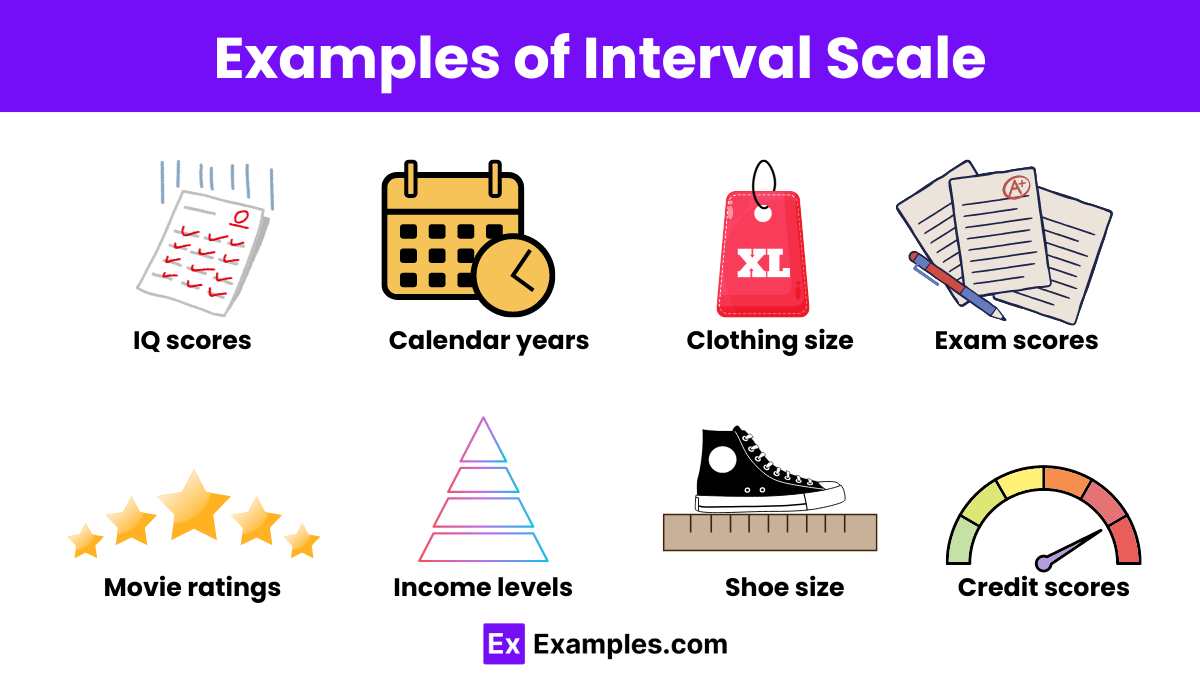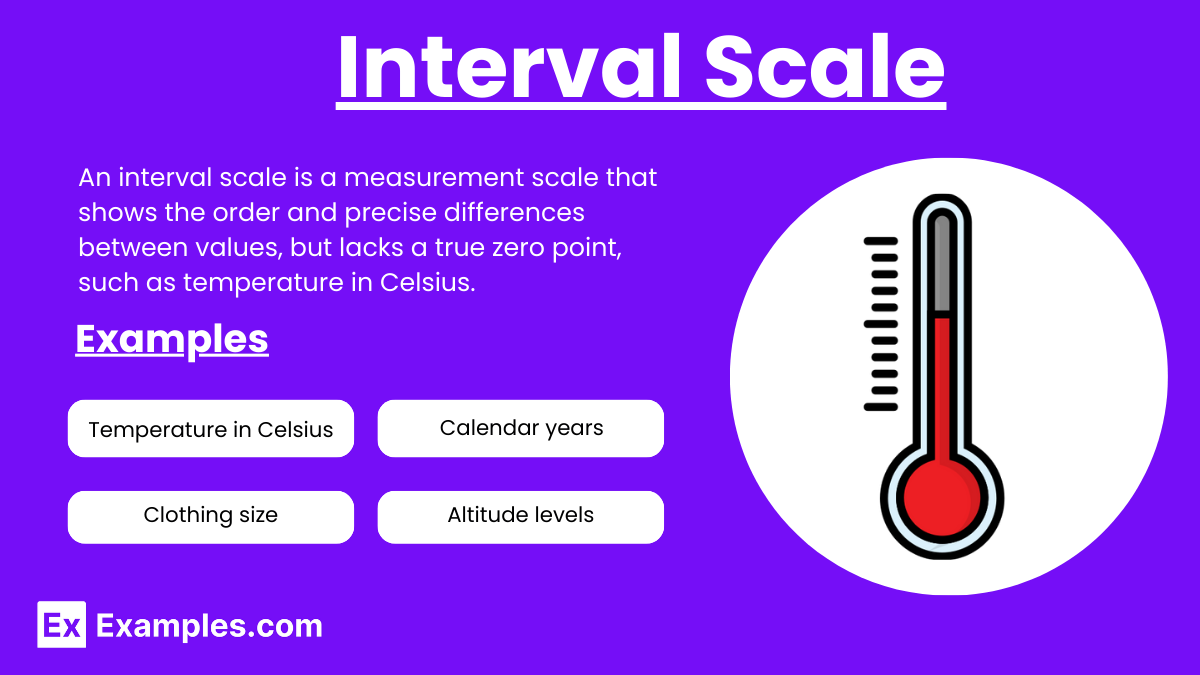18+ Interval Scale Examples to Download
An interval scale is a quantitative measurement scale where the intervals between values are meaningful and equal. Unlike ordinal data, which only ranks items in order, interval data allows for the measurement of the exact differences between values. This scale lacks a true zero point, meaning you cannot make statements about how many times greater one value is compared to another. Common examples include temperature in Celsius or Fahrenheit, where the difference between degrees is consistent and measurable.
What is interval scale?
An interval scale is a quantitative measurement scale where intervals between values are meaningful. Unlike ordinal scales, it lacks a true zero point, making it impossible to measure absolute quantities. Common examples include temperature in Celsius and IQ scores.
Examples of Interval Scale

- Temperature in Celsius
- Temperature in Fahrenheit
- IQ scores
- SAT scores
- Credit scores
- Time of day (on a 12-hour or 24-hour clock)
- Calendar years
- pH levels
- Shoe size
- Clothing size
- Dates (in a calendar year)
- Customer satisfaction ratings (on a numerical scale)
- Movie ratings (on a numerical scale)
- Exam scores (percentage)
- Income levels (in ranges)
- Likert scale responses
- Standardized test scores
- Altitude levels (above sea level)
- Blood pressure readings (systolic and diastolic values)
Types of Interval Scale
- Temperature Scales – Celsius and Fahrenheit measure units of temperature differences with consistent intervals.
- Standardized Test Scores – IQ scores, SAT scores, and other academic assessments.
- Credit Scores – Numeric representation of creditworthiness, with equal intervals between scores.
- Time Scales – Time of day measured on a 12-hour or 24-hour clock.
- Calendar Years – Years in history or future with consistent intervals.
- pH Levels – Measurement of acidity or alkalinity with equal intervals.
- Customer Satisfaction Ratings – Surveys using numeric scales to rate satisfaction.
- Movie Ratings – Numeric ratings assigned to movies on a consistent scale.
- Likert Scale Responses – Survey responses on a scale (e.g., 1-5) with equal intervals.
- Altitude Levels – Measurements of elevation above sea level in consistent intervals.
Characteristics of Interval Scale
- Equal Intervals – The difference between any two consecutive values is consistent.
- No True Zero Point – Interval scales do not have an absolute zero, meaning zero does not represent the absence of the quantity.
- Quantitative Measurement – Interval scales, such as units of distance, provide numerical data that can be analyzed mathematically.
- Addition and Subtraction – You can meaningfully add and subtract values on an interval scale.
- Arbitrary Zero Point – The zero point is set arbitrarily and does not indicate a lack of the measured variable.
- Ranking Order – Like ordinal data, interval data can be ordered and ranked.
- Comparative Analysis – Differences between values can be compared, but ratios are not meaningful.
- Versatility – Used in various fields such as education, psychology, and climatology.
- Examples – Common examples include temperature (Celsius, Fahrenheit), IQ scores, and calendar years.
Interval Scale of Measurement in Research
- Equal Intervals: Values on an interval scale have consistent differences, allowing for meaningful addition and subtraction.
- No True Zero: Unlike ratio scales, interval scales lack a true zero point, which means zero does not signify the absence of the measured attribute.
- Statistical Analysis: Interval data, a type of quantitative data, supports various statistical techniques, including mean, standard deviation, and correlation analysis..
- Comparison: Researchers can compare differences between values, but not ratios. For example, 30°C is not “twice as hot” as 15°C.
- Examples in Research: Commonly used interval scales in research include temperature (Celsius and Fahrenheit), IQ scores, and standardized test scores.
- Survey Instruments: Interval scales are often used in surveys to measure attitudes, satisfaction, and opinions on a numerical scale, such as a Likert scale.
- Data Interpretation: The equal intervals enable researchers to interpret data precisely, facilitating clearer insights and conclusions.
Interval Scale of Measurement in Psychology
- IQ Scores – Measuring cognitive abilities with equal intervals between scores.
- Standardized Test Scores – Evaluating academic performance using tests like SAT or GRE with consistent score intervals.
- Likert Scale Responses – Gauging attitudes or opinions using a Likert Scale with equal intervals between numerical response options.
- Reaction Times – Measuring response times in psychological experiments, with consistent intervals between recorded times.
- Personality Assessments – Using numeric scales to assess traits with equal intervals, such as extraversion or neuroticism.
- Memory Test Scores – Evaluating memory performance with tests that have consistent scoring intervals.
Interval Scale of Measurement in Statistics
- Temperature in Kelvin – Measuring temperature with consistent intervals in Kelvin, where differences are meaningful but no true zero point exists..
- Time of Day – Recording hours and minutes on a clock with equal intervals, but lacking an absolute zero.
- Calendar Years – Tracking years with equal intervals, allowing comparison of differences over time.
- Standardized Test Scores – Analyzing academic performance using scores on number lines that have equal intervals but no true zero point.
- Survey Ratings – Using numerical scales, like Likert scales, where intervals between ratings are consistent.
- IQ Scores – Evaluating intelligence levels with equal intervals between scores, facilitating statistical analysis.
- pH Levels – Measuring acidity or alkalinity with consistent interval differences, useful in chemical and biological research.
- SAT Scores – Assessing student performance on a standardized scale with equal intervals between score points.
- Credit Scores – Representing creditworthiness on a numerical scale with consistent intervals for statistical evaluation.
- Income Brackets – Analyzing income levels with ranges that have equal intervals for comparative purposes.
Uses of Interval Scales
- Temperature Measurement – Recording temperatures in Celsius or Fahrenheit for climate studies and scientific research.
- Psychological Testing – Assessing cognitive abilities with IQ tests.
- Educational Assessment – Evaluating student performance with standardized test scores.
- Customer Satisfaction Surveys – Gauging opinions and satisfaction using Likert scales.
- Time Tracking – Measuring hours and minutes in time studies and scheduling.
- Health Assessments – Recording clinical measures like blood pressure levels.
- Market Research – Analyzing consumer preferences and behaviors with numerical ratings.
- Economic Studies – Evaluating economic indicators, such as price indices.
- Environmental Monitoring – Tracking pH levels and other environmental measures.
- Social Science Research – Measuring attitudes and opinions with interval-based survey responses.
Interval Scale vs. Ratio Scale – Differences
| Aspect | Interval Scale | Ratio Scale |
|---|---|---|
| True Zero Point | No true zero point; zero does not indicate absence | Has a true zero point; zero indicates absence |
| Example | Temperature in Celsius or Fahrenheit | Weight, height, or age |
| Addition/Subtraction | Addition and subtraction are meaningful | Addition, subtraction, multiplication, and division are meaningful |
| Ratio Comparisons | Ratios are not meaningful (e.g., 20°C is not twice as hot as 10°C) | Ratios are meaningful (e.g., 20 kg is twice as heavy as 10 kg) |
| Data Analysis | Supports mean, standard deviation, and correlation analysis | Supports all interval scale analyses plus geometric mean and coefficient of variation |
| Applications | Used in social sciences, psychology, education | Used in physical sciences, engineering, economics |
How is an interval scale different from an ordinal scale?
Interval scales have equal intervals between values, while ordinal scales only rank order without equal intervals.
Can you give an example of an interval scale?
Temperature in Celsius is a common example.
Why is there no true zero in interval scales?
Zero does not represent the absence of the attribute being measured.
How do you analyze data from an interval scale?
You can perform mathematical operations like addition and subtraction.
What are common uses of interval scales?
They are used in psychology, education, market research, and environmental monitoring.
Can you calculate the mean with interval scale data?
Yes, the mean is a valid measure for interval data.
Is IQ measured on an interval scale?
Yes, IQ scores are measured on an interval scale.
Are Likert scales considered interval scales?
Yes, Likert scales are often treated as interval scales for analysis.
How do interval scales differ from ratio scales?
Ratio scales have a true zero point, allowing for meaningful ratio comparisons.
Can you multiply or divide interval scale data?
No, multiplication and division are not meaningful on interval scales.



